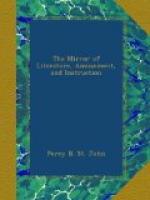“There is not a stone of that accursed building standing upon another. The property has passed to a family of a different name, and the series of incessant calamity which pursued all concerned in this cruel deed is as romantic as true.”
Visit to the Eagle’s Cliff, in Inniskea.
We ascended the hill (while the crew were clearing and baiting their spillets) in the vague hope of getting a shot at these predatory birds, of whose spoliations we had heard so much on the preceding evening.
On reaching the bottom of the rock, in whose face the aerie stands, we discovered that the old birds were absent, and as the nest was formed in a deep fissure, we could not ascertain its situation exactly. But that the eagles’ dwelling was above us was evident, enough: the base of the cliff was strewn with bones and feathers, and the accumulation of both was extraordinary. The bones of rabbits, hares, and domestic fowls, were most numerous, but those of smaller game, and various sorts of fish, were visible among the heap.
Many attempts are annually made to destroy this predatory family. It is impossible to rob the nest. Situated two hundred feet above the base of the rock, it is of course unapproachable from below, and as the cliffs beetle over it frightfully, to assail it from above would be a hazardous essay. An enterprising peasant, some years since, was let down by a rope and basket,—but he was fiercely attacked by the old birds, and the basket nearly overturned. Fortunately the cord was strong and had sufficient length to allow his being lowered rapidly, or he would have undoubtedly sustained some bodily injury from the wings and talons of those enraged and savage birds.
The village of Dugurth suffers heavily from its unfortunate proximity to the aerie. When the wind blows from a favourable point, the eagle in the grey of morning sweeps through the cabins, and never fails in carrying off some prey.
To black fowls eagles appear particularly attached, and the villagers avoid as much as possible rearing birds of that colour.
A few days before, one of the coast-guard, alarmed by the cries of a boy, rushed from the watch-house; the eagle had taken up a black hen, and, as he passed within a few yards, the man flung his cap at him. The eagle dropped the bird; it was quite dead, however, the talons having shattered the back-bone. The villagers say (with what truth I know not) that turkeys are never taken.
That the eagle is extremely destructive to fish, and particularly so to salmon, many circumstances would prove. They are constantly discovered watching the fords in the spawning season, and are seen to seize and carry off the fish. One curious anecdote I heard from my friend the priest. Some years since a herdsman, on a very sultry day in July, while looking for a missing sheep, observed an eagle posted on a bank that overhung a pool. Presently the bird stooped and seized a salmon, and a violent struggle ensued; when the herd reached the spot, he found the eagle pulled under water by the strength of the fish, and the calmness of the day, joined to drenched plumage, rendered him unable to extricate himself. With a stone the peasant broke the eagle’s pinion, and actually secured the spoiler and his victim, for he found the salmon dying in his grasp.




